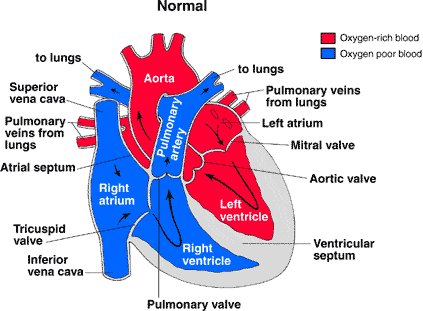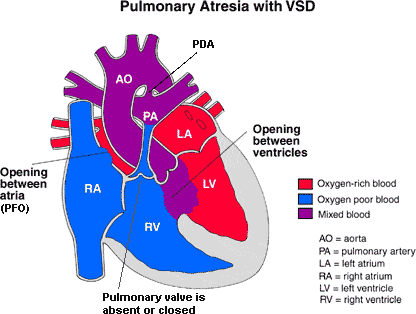Pulmonary atresia is a problem with the heart valve that lets blood flow from the heart to the lungs. It is congenital, which means your baby was born with it. The exact cause is not known.
The normal heart
- The heart has four chambers. The two upper chambers are the atria. The two lower ones are the ventricles.
- The heart has four valves. The valves open and close to keep blood flowing forward through the heart. The right side of the heart takes in blood from the body that is low in oxygen and pumps it to the lungs. The left side of the heart takes in blood from the lungs that is high in oxygen and pumps it to the body.
- The ductus arteriosus is a normal part of a baby’s heart before birth. This blood vessel connects the pulmonary artery and the aorta. It lets blood flow between the two vessels. It normally
closes shortly after birth. If it stays open, it is called a patent ductus arteriosus (PDA). - The foramen ovale is also a normal part of a baby’s heart before birth. It is an opening in the wall (septum) between the atria. It normally closes a few weeks after birth. If it stays open,
it is called a patent foramen ovale (PFO).

What is pulmonary atresia?
The pulmonary valve is between the right ventricle and the pulmonary artery. When it does not form correctly, it is called pulmonary atresia. Because the valve does not open, blood can’t flow into the
lungs. This is not a problem before the baby is born because the lungs are not working yet. The PFO lets blood go from the right to the left side of the heart. Pulmonary atresia can happen with or without a hole in the septum. If there is a hole, it is called a ventricular septal defect (VSD).
- With a VSD, blood flows back and forth between the two ventricles, which helps the right ventricle grow.
- Without a VSD, little blood flows into the right ventricle. The right ventricle does not grow and stays small.
There may also be problems with the coronary arteries. These are the blood vessels that bring blood to the heart muscle itself.

What are the symptoms?
The symptoms of pulmonary atresia are normally seen just after birth. These babies are often very sick. Symptoms include:
- Blue color in the skin.
- Trouble breathing.
- Fast breathing.
- Fussiness.
- Tiredness.
- Pale, cool, and clammy skin.
- Trouble feeding.
How is it diagnosed?
- It may be found with a fetal ultrasound before a child is born. This test uses sound waves to form a picture of the baby’s heart. This test can be done once the mother is 16 weeks pregnant.
- If it is not found before birth, signs of a heart problem may be found during a physical exam shortly after birth.
- If a heart problem is suspected, your child will be referred to a pediatric cardiologist. This is a doctor who diagnoses and treats heart problems in children. Several tests may be done.
These include:
- Chest X-ray. Shows the chest, including the lungs and the heart.
- Electrocardiogram (EKG). Records the heart’s electrical activity.
- Echocardiogram (echo). Looks at a moving picture of the heart.
- Pulse oximeter or oxygen saturation test. Measures the oxygen level in the blood.
How is it treated?
- Newborns with pulmonary atresia need both a PFO and PDA so blood can get to the lungs and the body.
- Before surgery, newborns may be given medicine through an IV to keep the PDA open. This lets blood flow from the aorta to the pulmonary artery to receive oxygen.
- A cardiac catheterization may be needed.
- Your child’s cardiologist or surgeon will talk with you about the best treatment. Surgery to repair pulmonary atresia is normally done in stages. It starts shortly after birth. The purpose of
surgery is to redirect blood flow to the lungs and body. The type of surgery depends on the size of the right ventricle. - After surgery your baby will go to the cardiac intensive care unit to be monitored. Your baby may be in the hospital for at least 1 to 2 weeks.
What are the long term concerns?
- After surgery, your child is at risk of ongoing heart problems. Your child may need to take medicines regularly to manage symptoms and improve heart function. Your child may also
need more surgery. Regular follow-up visits with the cardiologist are needed for the rest of your child’s life. - Most of the time, children with pulmonary atresia can be active. The type and amount of physical activity vary with each child. Check with the cardiologist about what activities are right
for your child. - Your child may need to take antibiotics before having any surgery or dental work. This is to prevent infection of the inside lining of the heart and valves. This infection is called infective
endocarditis. Your child should take antibiotics as directed by the cardiologist.
Home Monitoring Program
Your baby may go home with a baby scale and a machine that measures the amount of oxygen in your baby’s blood. It is called a pulse oximeter. You will be given a special book to keep a record of
your baby’s feeding schedule, oxygen level, and weight. The cardiology nurse practitioners will teach you how to do this before your baby leaves the hospital. They will let you know when and who to call if you have questions or concerns.



